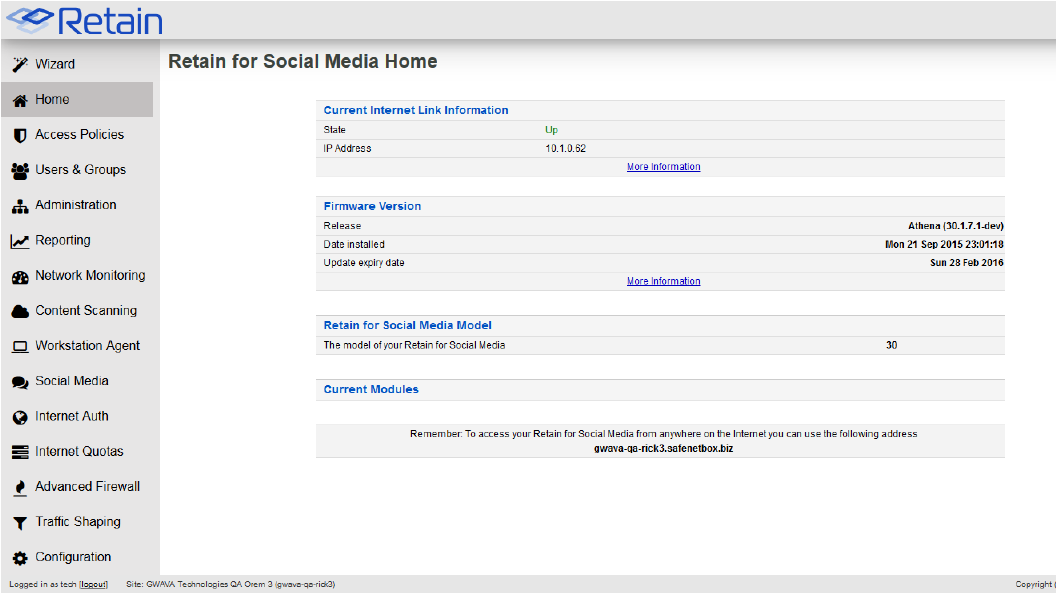5.25 Retain for Social Messaging Gateway
5.25.1 Setting up the VM & Installing the OS
Before setting up the Virtual Machine
Ensure the firewall is configured as such:
oFrom RSM WAN IP to Untrusted, all TCP/UDP ports
oIf the RSM WAN IP is a private IP, it needs to be NATed to an appropriate routable IP address. The LAN IP address does not need a corresponding inbound NAT rule.
NOTE:It is critical that these firewall rules are in place before proceeding.
5.25.2 Configure the Virtual Machine
-
Download the ISO from the link found in the Social module page, on the ‘Download RSM ISO’ tab.

-
Install it onto a VM or to the desired machine with the following minimum specs:
-
2GB RAM (minimum)
-
2 CPU cores (minimum)
-
60 HDD (minimum)
-
The recommended RAM, CPU and HDD specification will be determined by the expected load and size of the organization being served. Consult your Micro Focus technical representative.
-
2 NICs - vmxnet 3, ensuring the interfaces are in different VLANs. NOTE: The second NIC in the VMware settings list is the primary NIC that will be used for proxy traffic. This NIC will be labeled “Internet” on the RSM. The first NIC will be the “Local” port, and may be disconnected if desired when configured.
-
Redhat Linux enterprise 5 64bit base OS (selected from the dropdown list when setting up the VM – there is no need to actually install the Redhat OS)
-
-
Mount the ISO and start up the VM or server.
-
Set the password for the “tech” and “admin” users. This will then install the RSM OS. Once it’s installed and has come back up after the reboot, the RSM will have the default LAN IP of 192.168.0.254/24. The WAN interface will try to obtain an IP address from DHCP.
-
Set the LAN IP via the console by sending a ctrl-alt-ins and then follow the prompts.
-
All configuration operations are via the web user interface. Log onto the RSM interface by browsing to the LAN IP on either port 80 or 443 and logging in as the “tech” user, (the “admin” user doesn’t have the required permissions).

You will initially be prompted to confirm the EULA and provide your details. If the email address is not accepted at this stage (the RSM will try to validate all addresses), then use “root@ mail.RSM”.

-
Click the “Wizard” button from the left-hand navigation bar, and follow the prompts for setting the language, time zone and network details.
-
Once the network settings have been accepted, select Configuration -> Internet from the left-hand navigation pane, and check “Show Advanced Options”.
From the drop down list, next to “DNS server configuration” select “Always use static server” and then enter in the required DNS servers.
Click on Update.
Browse to
Configuration -> Apply and click on the “Apply Changes” button.
-
If the LAN IP Address has been changed in the Wizard setup, you will need to browse to the new IP address and log onto the RSM interface again after applying the network settings.
-
The WAN (or Internet) Interface of the RSM will be used for proxy traffic.
-
The LAN interface is not used for production traffic, but can be utilized as a management-type port if required.
-
It is critical that the two interfaces are configured on different subnets from this point on, regardless if the LAN port is utilized or not.
-
After the Network configuration has been completed you will be prompted to supply a sitekey. A sitekey is a unique identifier for your RSM and it should be relevant to your organization. Only alphanumeric and “-“ are accepted, with a minimum character count of 3.
-
a.Your RSM representative will supply the registration key to you.
-
b.After the sitekey has been successfully applied, your RSM will reboot.
-
-
Log back onto the RSM and browse to Administration -> Updates and click on “Run Update Now”.
The RSM will go through its update process, which could take up to 30 minutes and reboot multiple times.